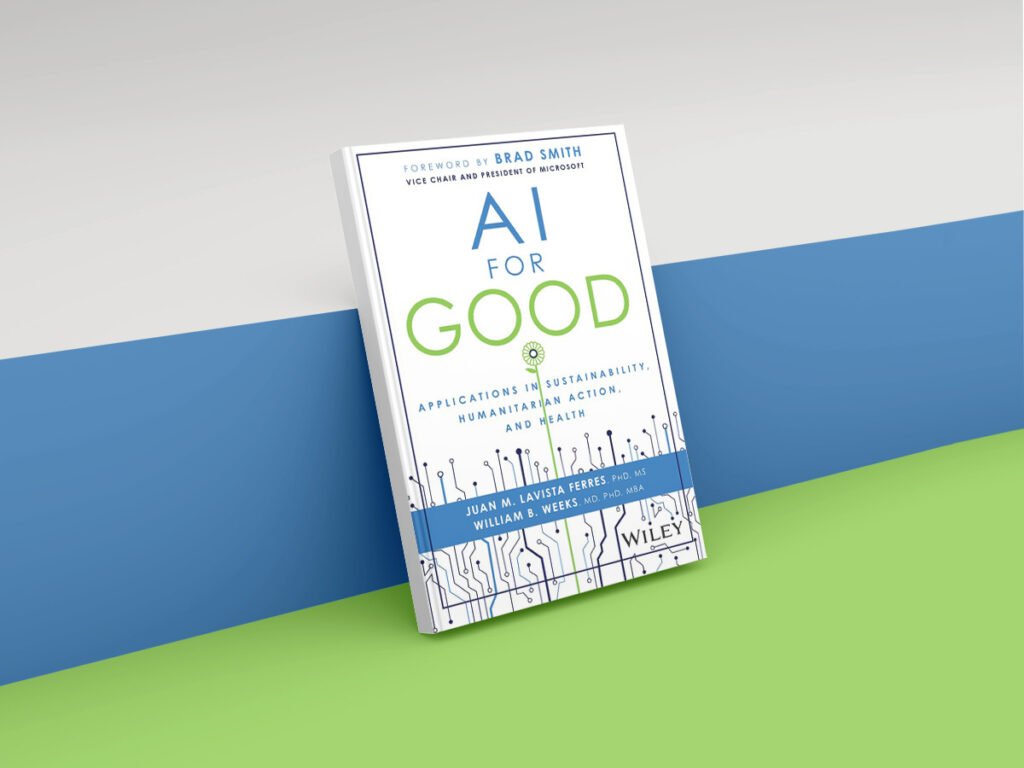
The relationship between AI and health, environmental sustainability, and humanitarian efforts is complex. On one hand, when it comes to vulnerable communities, AI has been used for surveillance, has perpetuated economic inequalities, and sometimes, has served as an instrument of violence and domination. Through irresponsible and biased models, AI has also exacerbated preexisting inequities in healthcare. On the other hand, AI has tremendous potential to help scientists, medical professionals, and researchers solve previously intractable problems and make good on technologists’ claims that AI will transform the world for the better. Ultimately, AI, like all technologies, is a tool that reflects the processes used to develop and deploy it.
Through his work with Microsoft’s AI for Good Lab, Juan Lavista Ferres, PhD, MS, is working to balance the scales by furthering the positive impacts of AI. He cofounded the AI for Good Lab in 2018, and since then, he and his team have worked on over 200 projects spanning the globe. Their partners include the United Nations, American Red Cross, The Nature Conservancy Group, PATH, Seattle’s Children’s Hospital, Harvard University, Stanford University, and Johns Hopkins University. The lab’s notable projects include population mapping among underserved and underrecognized communities for better resource deployment, understanding hazards like extreme heat in dense urban centers, and improving the detection of breast cancer and pancreatic cancer.
“If you only feed Caucasian data to a model, the Latin, African American, and Asian communities will not be represented.”
Ferres spoke with NPQ about his book, AI for Good: Applications in Sustainability, Humanitarian Action, and Health, which he coauthored with William B. Weeks, MD, PhD, MBA, the director of AI for health research at the AI for Good Lab. The book includes a series of case studies focused on the lab’s key projects that demonstrate the transformative potential of AI.
This interview has been edited for length and clarity.
Tonie Marie Gordon: There’s a lot of discussion about algorithmic bias. But it’s usually a problem of the data that systems are trained on. So, I want to know your thoughts on inclusivity and equity within AI systems, and how the irresponsible or irreflective use of data can harm vulnerable populations.
Juan Lavista Ferres: That’s a great question. Algorithmic bias is an important issue, and we cover it in the book. AI models learn from data. If the data has bias or if the data is not representative, the algorithm will have those same biases, and it won’t be representative.
“Data that is accurate and complete can still be unfair.”
Let’s take skin cancer as an example. Lots of models are trained to detect skin cancer, and early detection of cancers like melanoma is extremely important because if it’s done right, lives are saved. Moles on the skin can help diagnose the problem. But, for moles, most of the data that has been used to train these models comes from White, Caucasian people. Caucasians are predisposed to skin cancer. But, from a socioeconomic perspective, they also have a greater chance of being treated for skin cancer. So, the challenge is that if you use data on Caucasians to train the model, the model will only work well on Caucasian people. If you only feed Caucasian data to a model, the Latin, African American, and Asian communities will not be represented. This is an issue because the model cannot generalize to populations outside of the data used to train it. So, if you use these models in populations not represented in the training data, the model is likely to give false positives or false negatives.
The lack of generalizability makes three things clear. First, whenever we are building models, we need to carefully define the target population. Second, we need to make investments to ensure that the data used to train the model is representative of the target population. The third factor presents a bigger challenge: data that is accurate and complete can still be unfair.
Take bank loans, for example. If you have a thousand people who take out a loan, knowing their race or ethnicity will tell you very little about who will repay the loan. But if you know their disposable income, you could predict who will repay the loan. The challenge with disposable income is that it isn’t directly observable. You can observe income and you can observe demographic characteristics like race. And because disposable income varies by race, it could be used as an indicator of who will repay the loan. So, I could build a model that judges someone’s ability to repay the loan on their race or ethnicity, and that model would have predictive power, but it would also be completely unfair.
Sign up for our free newsletters
Subscribe to NPQ's newsletters to have our top stories delivered directly to your inbox.
By signing up, you agree to our privacy policy and terms of use, and to receive messages from NPQ and our partners.
We need to understand how these things work [in our current system], and we need to understand how a fair system works. We need to invest in the responsible use of AI.…And we need to understand where the use of AI may be unfair.
TMG: From your book, one of the things I thought was interesting is AI’s utility for helping us understand the medical literacy gap. Could you talk us through your work in that area?
JLF: This work is the result of a collaboration we’ve had with professors at Princeton University, who’ve been investigating this issue for a long time. We collaborated with them to better understand how people navigate the internet and how much accurate information versus disinformation they consume. What we discovered is that once people end up on a website with disinformation, because these sites link to other websites with disinformation, all subsequent navigations are usually to more disinformation. This creates what we call “rabbit holes.”
“This technology…gives more people the opportunity to have a [medical] conversation.”
Medical literacy is one of the challenges that, for us [at the AI for Good Lab], is critically important for society because we want to understand how people are navigating the web and what content they consume. This can help governments develop public awareness campaigns. For example, if you know from your study that a particular sector of a population is consuming a lot of disinformation like during the COVID-19 pandemic when some people groups were targeted by antivaccine disinformation, you also need to know how many are consuming the disinformation, what disinformation they’re consuming, and how they are consuming it. This helps with our awareness [as researchers]. And it can also help us understand what content should be created to counterbalance the disinformation.
TMG: While we’re on the subject of health information dissemination, a lot more organizations utilize chatbots to answer people’s health questions. What’s your perspective on their utility?
JLF: We did a study on this last year, which was published in JAMA [Journal of the American Medical Association] and mentioned in the book. In the study, they looked at a group of patient questions and compared answers from doctors and ChatGPT-4. They found that even if the model was not specifically trained to do so, the model provided more accurate answers than the doctors did. The answers from ChatGPT-4 were also found to be more empathetic as judged by a human. During this process, the humans doing the judging were not aware of which answers were provided by doctors and which were from AI. And I think what’s great about that research is it demonstrates what technology has the power to do, even if it’s not ready [for the public] today. We live in a world where about four billion people, or half the world’s population, do not have access to doctors. And this may not change because many people live in countries that do not have enough doctors per capita and people also live in remote areas of the world where there are no doctors or too few. This technology will not replace doctors, but it can help doctors be more productive by answering people’s questions and by conducting some basic screening. It also gives more people the opportunity to have a [medical] conversation.
TMG: What do you hope people get out of the book?
JLF: What we learned from this experience is that it is critical to help organizations understand how they could use AI. Early on in our journey, we realized that the best way to show the power of AI was to show people examples, even if the examples were not directly related to their area of focus. The examples still helped them understand what type of problems can be addressed with AI. The spirit of the book is to try to make that exercise that we’ve been doing with organizations available to more people so they can do it themselves. And that’s why the book has 27 different examples. So, our objective with the book is for people to find ways to use AI to solve their problems.
TMG: Is there anything that surprised you during the process of writing the book or in terms of people’s reactions? Were there any takeaways that you didn’t expect going in?
JLF: That’s a good question. This was my first book, and it was a lot of work. It took time and effort. I think that, if I could do it again, I would try to make it [even more] accessible. When I was developing the book, I was specifically targeting practitioners, the people that we work with. But after releasing the book, I found that there were a lot of people in the general public that want to learn more. We tried to make the book as accessible as possible, but it’s hard because, and I touched on this in the book, humans are addicted to complexity. We like complexity. We like complex projects. We like complex things. That’s the reason why we have jargon. And the jargon certainly doesn’t help. The idea of complexity doesn’t help either. Building complex solutions makes you feel good and makes other people believe that you’re intelligent. But if you want to help everybody in the world, your solution needs to be simple, and you need to learn how to speak in very simple terms so people can understand. We’ve tried our best to do that, but it’s difficult. Creating simple solutions and making things accessible is very challenging because people are often drawn to complexity, but this attraction is misguided.












